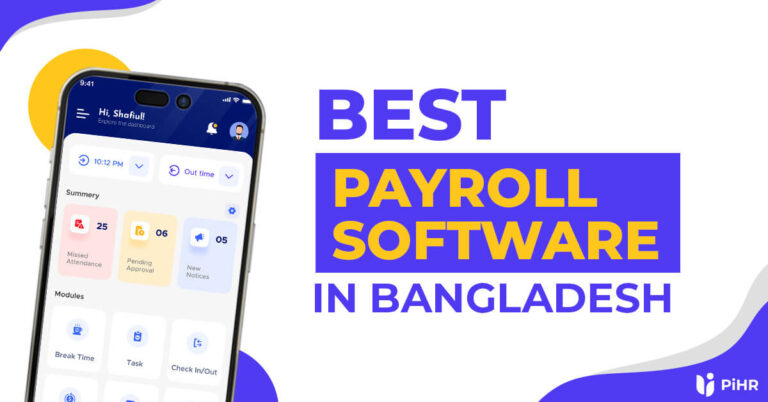Do you know how difficult it is for the HR Department to ensure proper attendance of employees? On paper, it sounds easy. But in reality, ensuring it reflects the most difficult task of the lot.
Why Is Attendance Important at Work
Attendance is of paramount importance to both employers and employees. Punctuality of employees helps increase productivity and ensure the smooth functioning of operations. Some major problems that arise from poor attendance are as follows:
- Punctual and dedicated employees get discouraged when they have to carry out others’ duties in addition to their own. Eventually, the efficient employees become demoralized with the chronic absenteeism of others, hampering adequate work progress.
- Employees that constantly miss the office, suffer from keeping up with company’s work pace and processes.
- Lower productivity, caused by absenteeism, may hinder project progress, leading to work delays and missed deadlines.
- Staffing costs increase as substitute employees are hired or existing employees work overtime to fill the “gaps”.
- Attendance falls under workplace ethics. Continuous absenteeism sends the wrong moral message to all concerned organizational members.
So how do you ensure proper attendance in your company culture? What drives an employee to attend the office timely and regularly? The answer lies ahead.
How to Address Employee Attendance
You need to have an employee attendance improvement plan to address this issue. The first step would be to leverage data to understand what the state of employee presence is.
There needs to be a tracking software that can track leaves of absence, which can give you data regarding people who are missing work. If you see that there are many employees missing work regularly, there is an underlying issue that needs to be addressed.
Secondly, you need to analyze what those underlying issues can be. Set up a meeting with those employees to see if you can figure out a plan to target these issues and solve them together. Many creative ways can help you improve employee presence and participation at work.
You can create a reward system for those who are showing up regularly. There needs to be a work culture where hard workers are rewarded, and those who are slacking off are held accountable for their actions.
This motivates employees to have a positive outlook toward punctuality and a negative one towards absenteeism. It also promotes a healthy work-life balance and ensures your employees aren’t overworked.
Additionally, you need to communicate expectations, implement policies, and train supervisors, to ensure that employee presence and participation are taken seriously.
Employee Attendance Improvement Plan
Rectifying attendance issues and ensuring proper attendance requires an employee attendance improvement plan. This plan primarily focuses on reducing absenteeism to a minimum level. This plan also facilitates enhancing productivity, increasing employee engagement, and ensuring work-life balance.
The attendance improvement plan requires some significant factors to be effective:
- Creating a workplace attendance policy is mandatory. This policy lays out all regulations of office timing, leave policy, overtime, and more. It should adhere to local labor laws, to avoid legal discrepancies in case such a situation arises. It should act as a guideline for all attendance issues.
- Tracking attendance via fingerprint attendance machines and attendance tracking software should be ensured. The patterns of absence should be noted, distinguishing between leave, tardiness, and overtime. PiHR Attendance Management Software is a great tool for this.
- Methods for analyzing and recording attendance problems should be chalked out.
- Employees need to be communicated properly about their attendance scenario. Their situations and problems need to be considered and necessary actions are taken.
Taking into consideration the above factors, the attendance improvement plan should be laid out. This plan would assist in coming up with ways to creatively improve attendance.
How to Create an Employee Attendance Improvement Plan
If there are attendance problems, there also will be solutions. We suggest 10 creative ways to improve attendance and reduce absenteeism and tardiness at the workplace.
Developing Digital Engagement Initiatives
COVID-19, since 2019, shifted work plans and executions to online platforms. Hence, initiatives should be taken to develop virtual events, games and engaging content. This will help build a long-term digital HR plan, ensuring strong employee attendance.

Analyzing Employee Attendance with Analytics
In this age of digitalization, digital reports and attendance management software like PiHR’s can be used for detailed analysis. Visually engaging dashboards may be used to show data and patterns to both management and employees. This will help them understand and improve performance.
Communicating Workplace Attendance Plans Innovatively
Using digital methods and integrated platforms, HR can communicate attendance policies to employees. Using animated case studies or gamified simulations involving the consequences of absenteeism will implant a thought in the employees’ mind about the importance of proper attendance.

Arranging a Gamified Competition
The HR can organize a periodic competition involving rewards and points for “Perfect Attendance”. Top performers may be listed down in a leaderboard for all to see and be encouraged.
Awarding Higher Attendance with Monetary Value
If possible, the management can reward those maintaining perfect attendance or near, by adding stipend to their monthly salaries. This will encourage others to follow suit and be more punctual and regular to the office.
Training Managers on Attendance Management
The company can train departmental managers to learn various digital attendance management systems with relevant attendance tracking software. ZKTeco Attendance Machines, for example, are comprehensive yet easy to use, which may be taught to managers to operate. They may also be taught to interpret attendance dashboards to understand current situations. Most importantly, they should be clearly communicated about the attendance policies and plans.
Availing Reports to All Devices
The world is going mobile and nano, day by day. Thus, availing of real-time reports to mobile devices (tabs and smartphones) is a must. HR software like that of PiHR, may be used to communicate attendance updates to employees and employers. That too in real-time, allowing instantly updated information.
The mobile device attendance report can also signal employees taking necessary steps in maintaining attendance. It allows employers to track employee attendance as well, advising employees to attend office or not to, based on circumstances.
Allowing Flexibility and Shifting Work
Regardless of position or role, employees should be encouraged to work in shifts, keeping the operations ongoing. Shift Management systems integrated with attendance tracking can help in these. Like the one of PiHR, shift management modules help set up rosters. These digitally formed rosters may be viewed on any synced device in any digital platform, helping employees know and adapt accordingly.
This strategy will allow employees to work in rosters and adjust work-life balance. This will keep them happy as they get to select timely work hours, rather than timed ones.
Constituting an Engagement Committee
Having an Employee Engagement Committee will allow the committee members to plan out engagement initiatives. Of course, a budget should be set. But if select employees and managers arrange “fun” initiatives, like games sessions or “themed hangouts”, to motivate their colleagues, this will improve attendance in a big way.
Empowering Employees
Finally, an organization should run the whole attendance system empowering the employees. The employees should have their say in development of the attendance improvement plan (discussed above) on a continual basis. They should be provided with constant digital feedback on official social media or platforms. They should feel endorsed and acknowledged.
Track Staff Leave
When handling a company, you’ll have plenty of employees on leave for various reasons. There are sick leaves, a plethora of paid and maternity leaves, and other reasons behind why an employee isn’t at work. You can’t know how many leaves someone has taken, or who is on leave at what time unless you are properly tracking staff leave. This will also help you be fair, and avoid any legal issues.
The days of manually tracking leave are over. Most companies nowadays either use spreadsheets or some extension of HR and Payroll software that allows companies to track employee leave. If you’re also looking for HR software that can help solve this issue, you may want to look at PiHR’s Employee Leave Management feature.
Set Clear Expectations
The culture you have at your company will determine how many leaves an employee takes. There isn’t a correct approach to setting expectations, but the point is that clear expectations always have to be communicated effectively. You must let your employees know from the start what kind of a work environment you are trying to create.
If you are working on a project with harsh deadlines, the hustling work dynamic will be fast-paced, and there will be little room for leaves unless there’s a severe emergency. In the same vein, if the project is a slow-paced one with very flexible deadlines, there may be more room for employees to take leave.
In conclusion, no approach is wrong. However, you will have to communicate what your approach is. If you are not communicating properly with your employees, they won’t understand what is expected of them.
Boost Morale and Employee Engagement
If there’s a work culture of very high absenteeism, the overall morale will go down. To make sure your employees have a boosted morale, and there is high engagement, you will need to provide positive reinforcements in place to encourage them. You should also ensure that your employees are not being overworked, as more stress leads to less productivity as well.
You should always reward and appreciate employees who are performing well, and there must be mechanisms in place to recognize their hard work. This is the “carrot over the stick approach,” where instead of punishing absent employees, you are rewarding those who are working harder. This creates a culture of positive reinforcement and provides incentives to employees to show up to work regularly.
Reduce Sick Leave
This sounds very counterproductive and cruel at first. Don’t get us wrong, we are not suggesting that you force your sick employees to come to work. What we’re suggesting is that you put mechanisms in place that prevent employees from getting sick in the first place.
Many illnesses are quite preventable with better hygiene, a good diet, and better access to healthcare. There are rules you can set in the workplace about hygiene; wearing masks, making portable sanitizers available at work, etc. You can also allocate some budget to providing healthy snacks like fruits and nuts at the office. Not to mention, having a wellness culture in the office like promoting mental well-being is also an important factor.
When all of these efforts are combined, the chances of getting sick are indirectly reduced, which may lower the amount of sick leave that an employee has to take.
Be Transparent About Employees' Expectations
If you are planning on having a rigorous, fast-paced work environment where the employees need to meet immediate and harsh deadlines, and they must hustle, you need to be transparent about that. Similarly, if your work environment is relaxed, where employees can expect looser deadlines and more leaves, you need to be transparent about that too.
The bottom line is, that you need to be transparent about what your employees can expect out of your company’s work environment. If they sign up for a relaxed office but are constantly made to hustle all day, they are going to be burned out and demotivated. The expectations should be set from the get-go.
Communicate with your team
You shouldn’t take an aggressive approach if an employee is consistently taking leaves of absence. Instead, we recommend that you communicate with empathy. Look into why they are being absent for work, and if you can provide resources for them to help them feel better. Clear communication always goes a long way.
Additionally, if an employee is returning after a long absence, make sure to set up a meeting with the rest of the team members when they return to work. This meeting can help that employee get updates from the team, and it will allow you to evaluate if the employee is feeling well enough to return to work.
Train your Supervisors in Policy and Procedure
Your supervisors themselves need to be well versed in company policy about employee absence. You need to check in with your supervisors to see if they are familiar with company policy, and how they handle employee absences.
This is best done by setting a meeting with them and making sure they are aware of specific company procedures regarding handling leaves of absence. Are they also aware of the consequences that employees must face in light of policy violations? Are they good at conflict resolution and mediation?
Ideally, there should be periodic training sessions for supervisors to ensure they are not aggressively treating their employees about absence, but also that they are being fair and strict when they need to be.
Be Consistent
It’s important to show that your actions reflect your words. If you have set expectations and you are not taking any action against those who are violating those expectations, then you are not being consistent.
You should always make sure that employees receive consequences for violating policy. However, you should also ensure to encourage and reward those who are following through with the previously established expectations.
Identify the Root Problem of Poor Attendance
Employees don’t usually miss work for no reason. You first need to understand what is causing employees’ absences. There are a plethora of reasons why someone is missing work. There can be family emergencies. People also miss work due to poor health and well-being. Some people miss work because of high levels of job dissatisfaction.
Set up a meeting with employees who are missing work, or ask their team leaders or supervisors to do so. Try to find out what is causing these recurrent absences and what the company can do about it.
If the employee is chronically ill, there are ways to adjust their schedule and make work more flexible to accommodate their illness. If the problem is job dissatisfaction, there are ways to improve the overall work culture within the workplace, to make it more inclusive and fun.
Create an Attendance Tracker
We’ve touched a bit on this before, but tracking your employees’ attendance is key to improving it. Everyone should clock in when they reach work, and clock out when they are leaving it. This way, you have complete data about the working hours. When employees recognize that it’s being tracked, they are going to take showing up to work a lot more seriously.
You can also use manual tracking or spreadsheets to achieve this, but the most commonly used device is employee “key cards” which need to be punched in and out upon arrival and departure. This is tracked through tracking software. There is a plethora of tracking software available that you can leverage to achieve this.
You can also take a look at PiHR’s attendance management software for more information.
Effect of Good Attendance Management System and Bad Management System
The systems in place need to be effective in solving the problem you are trying to solve. If you don’t have a proper management system in place, it can be severely counterproductive for the company. Let’s take a look and analyze how a bad management system can impair a company’s growth and productivity.
| Feature | Good Management System | Bad Management System |
|---|---|---|
| Productivity and Morale | A good management system will allow employees to feel safe and appreciated. This leads to an overall boost in productivity and morale. When you are consistent in your values and you adequately have a system in place to reward good participation, employees will be motivated. | A bad management system will allow employees to feel unsafe and demotivated at work. This leads to low productivity and work, leading to overall poor communication within the team, and harming the company. |
| Absenteeism and punctuality rate | If employees feel that coming to work on time and regularly will lead to more rewards and appreciation, and everyone is held accountable for their actions, absenteeism will decrease | If employees don’t feel that others are being held accountable for poor attendance, they are not going to feel motivated to come to work. Absenteeism will decrease and punctuality will increase. |
| The overall impact on company culture | Good management leads to better collaboration, better teamwork, and an improved work culture. | Bad management practices lead to poor communication and collaboration, leading to fractures within the company, and affecting overall company health. |
| Turnover Rates | With a good management practice in place, turnover rates are incredibly low. This means that employee retention rates are high. | Bad management will lead to higher turnover rates and low retention for the company. |
| Costs | Good management leads to low absenteeism. This means you don’t need to replace any absent workers, helping to reduce costs related to absenteeism. | Bad management leads to high absenteeism. When you have multiple absent employees, there is a higher cost of replacing them. |
Why Can't you Ignore Employee Absenteeism
Employee absenteeism is a disease for the company, and will negatively impact the overall company health. When you have high rates of absenteeism, it means that the company is running on low productivity. Due to absences, deadlines can easily be missed, even when meeting those deadlines is crucial for the company. Not to mention, it leads to high levels of stress within the workplace for the team and leads to overwork and exhaustion.
When the rest of the team members have to pick up the pieces and do all the work by themselves, it leads to poor performance. This unequal distribution of work also results in worse products being produced ultimately, leading to poor customer service and poor customer satisfaction.
Overall, this is bad news for the company. Hence, it is unstrategic for you to ignore employee absenteeism, as it leads to losses and harms the company.
Why an Attendance Improvement Plan is your Business's Best Friend
We have already discussed why you can’t ignore employee absenteeism as it leads to overall poor company health. The question you need to ask yourself now is: what’s next? The next step would be to create an attendance improvement plan because that will be your business’s best friend.
Without a comprehensive improvement plan, you cannot fix the underlying issues caused by high rates of absenteeism. If there are large numbers of employees missing work regularly, then there needs to be a shift in employee management. Having an improvement plan will work wonders for pyour company.
An attendance improvement lan will significantly change how your company operates. You will have higher productivity among employees, higher employee morale, better retention rates, better collaboration and communication within teams, and overall, higher profits for the company.
Measuring Success and Continuous Improvement
There are many steps you can use to measure success.
- Look at your key performance indicators (KPIs) and compare them. How are you performing after implementing the aforementioned strategies compared to before? This will help you measure how much improvement has occurred since those policies and strategies have been implemented.
- Revenue and profit are always good, quantifiable metrics to measure success. If your company’s revenue and profit are higher than before, that means you have implemented good management techniques, and should continue implementing them in the future.
- You should also monitor employee engagement. Since implementing an attendance tracker, how has attendance improved? You can look at these objective data and decide for yourself how overall performance has improved.
- Look at growth potential and see how much more you can expand your market share.
Building a culture of continuous improvement is pivotal for your company. There are several ways through which this can be achieved.
- Set measurable, quantifiable goals for the company which are easy to track. Set goals within the workplace for minimum attendance, and look back and evaluate if those goals were met. Set specific deadlines for teams, and supervise if those deadlines are being met.
- Continue a culture of providing rewards and appreciation. One of the biggest reasons behind high turnover and absenteeism is low job satisfaction. If your employees are feeling appreciated and validated in the workplace, then there won’t be any issues with job satisfaction.
- Create a positive work culture where employees can share their personal issues and struggles, and emphasize the importance of mental health in the workplace. If your employees are overworked and stressed, they will be burned out eventually and it will lead to low productivity.
- Implement a PDCA cycle (plan-do-check-act), to make sure there are measurable goals that employees are working towards. This will help keep them motivated and lower absences.
Best Attendance Tracking and Improvement software
PiHR is widely known as the best HR and Payroll software. Trusted by over 400 companies, PiHR can manage and track your employees’ attendance effectively.
Some of our features include Attendance Management, Employee Management, and Employee Leave Management. All of these features can be coopted in creating a seamless employee attendance improvement plan.
If you are curious about our features and have questions, feel free to visit PiHR.













